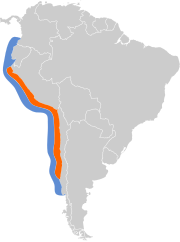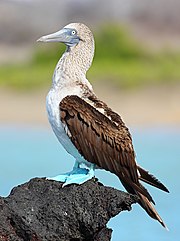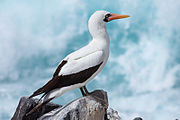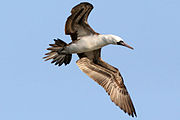Booby
| Booby Temporal range: Miocene (Langhian) – recent[1]
| |
|---|---|

| |
| Blue-footed booby displaying by raising a foot | |
| Scientific classification | |
| Domain: | Eukaryota |
| Kingdom: | Animalia |
| Phylum: | Chordata |
| Class: | Aves |
| Order: | Suliformes |
| Family: | Sulidae |
| Genus: | Sula Brisson, 1760 |
| Type species | |
| Pelecanus leucogaster Boddaert, 1783
| |
| |||||||||||||||||||||||||||||||||
| Cladogram showing the species in the genus Sula.[2] |
A booby is a seabird in the genus Sula, part of the family Sulidae. Boobies are closely related to the gannets (Morus), which were formerly included in Sula.
Systematics and evolution
The genus Sula was introduced by the French zoologist Mathurin Jacques Brisson in 1760.[3] The type species is the brown booby.[4] The name is derived from súla, the Old Norse and Icelandic word for the other member of the family Sulidae, the gannet.[5]
The English name "booby" was possibly based on the Spanish slang term bobo, meaning "stupid",[6] as these tame birds had a habit of landing on board sailing ships, where they were easily captured and eaten. Owing to this, boobies are often mentioned as having been caught and eaten by shipwrecked sailors, notably William Bligh of the Bounty and his adherents during their famous voyage after being set adrift by Fletcher Christian and his followers.
Six of the ten extant Sulidae species called boobies are in the genus Sula, while the three gannet species are usually placed in the genus
The fossil record of boobies is not as well documented as that of gannets, either because booby speciation was lower from the late Miocene to the Pliocene (when gannet diversity was at its highest), or because the booby fossil species record is as yet incomplete, due to most localities being in continental North America or Europe despite boobies' more tropical distribution.
Behaviour
Boobies hunt fish by diving from a height into the sea and pursuing their prey underwater. Facial air sacs under their skin cushion the impact with the water. Boobies are colonial breeders on islands and coasts. They normally lay one or more chalky-blue eggs on the ground or sometimes in a tree nest. Selective pressures, likely through competition for resource, have shaped the ecomorphology and foraging behaviours of the six species of boobies in the Pacific.[9]
List of species
| Common name | Scientific name and subspecies | Range | Size and ecology | IUCN status and estimated population |
|---|---|---|---|---|
| Blue-footed booby | Sula nebouxii , 1882
Milne-Edwards Two subspecies
|
Gulf of California down along the western coasts of Central and South America down to Peru
|
Size: Habitat: Diet: |
LC |
| Brown booby | Sula leucogaster , 1783)
(Boddaert Four subspecies
|
islands and coasts in the pantropical areas of the Atlantic and Pacific oceans
|
Size: Habitat: Diet: |
LC |
| Masked booby | Lesson , 1831
Foursubspecies
|
islands in tropical oceans
|
Size: Habitat: Diet: |
LC |
| Nazca booby | Sula granti , 1902
Rothschild |
eastern Pacific from the islands in Baja California to the Galapagos islands and the Isla de la Plata in Ecuador and Malpelo in Colombia
|
Size: Habitat: Diet: |
LC |
| Peruvian booby | Sula variegata , 1843)
(Tschudi |
Peru
|
Size: Habitat: Diet: |
LC |
| Red-footed booby | Sula sula , 1766)
(Linnaeus Three subspecies
|
Sri Lanka, Christmas Island, eastern central Pacific
|
Size: Habitat: Diet: |
LC |
References
- ^ "Sula Brisson 1760 (booby)". PBDB. Archived from the original on 2021-08-08. Retrieved 2019-07-08.
- PMID 21144905.
- ^ Brisson, Mathurin Jacques (1760). Ornithologie, ou, Méthode contenant la division des oiseaux en ordres, sections, genres, especes & leurs variétés (in French and Latin). Vol. 1. Paris: Jean-Baptiste Bauche. Vol. 1 p. 60, Vol. 6 p.494.
- ^ Mayr, Ernst; Cottrell, G. William, eds. (1979). Check-list of Birds of the World. Vol. 1 (2nd ed.). Cambridge, Massachusetts: Museum of Comparative Zoology. p. 181. Archived from the original on 2021-08-08. Retrieved 2017-11-21.
- ^ "Sula, n.". Oxford English Dictionary (Online ed.). Oxford University Press. (Subscription or participating institution membership required.)
- ^ "booby, n.". Oxford English Dictionary (Online ed.). Oxford University Press. (Subscription or participating institution membership required.)
- S2CID 82903466.
- hdl:10088/6553. Archivedfrom the original on 2021-04-10. Retrieved 2017-11-22.
- .
- . Retrieved 13 November 2021.
- . Retrieved 13 November 2021.
- . Retrieved 13 November 2021.
- . Retrieved 13 November 2021.
- . Retrieved 13 November 2021.
- . Retrieved 13 November 2021.
External links
- Videos of several Booby species on The Internet Bird Collection. Archived 12 April 2016 at the Wayback Machine.






